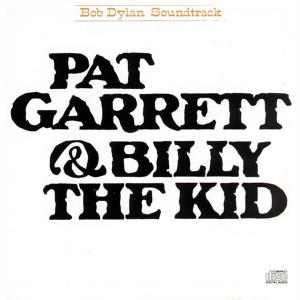
Pat Garrett and Billy the Kid (1973)

1. Billy (Main Title Theme)
2. Cantina Theme (Workin' for the Law)
3. Billy 1
4. Bunkhouse Theme
5. River Theme
6. Turky Chase
7. Knockin' On Heaven's Door
8. Final Theme
9. Billy 4
10.Billy 7
By the early 1970s, Bob Dylan had already begun weaving Western motifs into his musical tapestry, so it was no great revelation when he aligned himself with Sam Peckinpah’s revisionist Western Pat Garrett & Billy the Kid. Still, what emerged from the collaboration was less a full-bodied Dylan album than a moody, fragmented sonic backdrop—part film score, part folk ghost story.
It would be misguided to judge this release by the traditional standards of a singer-songwriter album. This was a film soundtrack first and foremost, and Dylan the performer often takes a back seat to Dylan the mood-setter. The songs drift in and out of focus, most of them instrumentals, sparse and deliberate, conjuring dusty saloons and sun-scorched plains more through texture than melody. There's little to cling to in the way of lyrics or choruses—Dylan's unmistakable voice is heard on only a select few tracks.
Much of the music is stitched together from brief, evocative pieces. Titles like Billy 1, Billy 4, and Billy 7 suggest alternate takes or evolving sketches rather than finished songs. The repetition of the name hints at a shifting narrative identity—versions of the outlaw’s tale told in glances and murmurs. Likewise, tracks such as Bunkhouse Theme and River Theme feel more like ambient scene-setting than standalone compositions.
Technically, the recordings have a rough, almost demo-like quality. Studio noises bleed through—ambient sounds, mic pops, and at one point, even the faint echo of a cough. Far from detracting, these imperfections underscore the album’s ramshackle charm, situating it in the analog world of creaking floorboards and creased wanted posters. It feels lived in.
There is, however, one moment of undeniable transcendence: Knockin’ on Heaven’s Door. It emerges with the clarity and conviction of a sermon. Placed within the cinematic context of death and redemption, it feels even more powerful than in its many later incarnations. Unfortunately, it has become so culturally omnipresent—covered, quoted, and appropriated—that it now suffers the fate of all great works that outgrow their origin: it’s overplayed, though not necessarily overrated.
Dylan also appeared on screen in the film itself, contributing a soft-spoken, enigmatic presence. Critics were divided—some intrigued, others bemused—but his musical contribution, though unconventional, remains a haunting companion to Peckinpah’s dusty elegy. Pat Garrett & Billy the Kid isn’t a Dylan album in the traditional sense, but a mood piece—a whispering echo from the ghost towns of Americana.
Go back to the main page
Go To Next Review